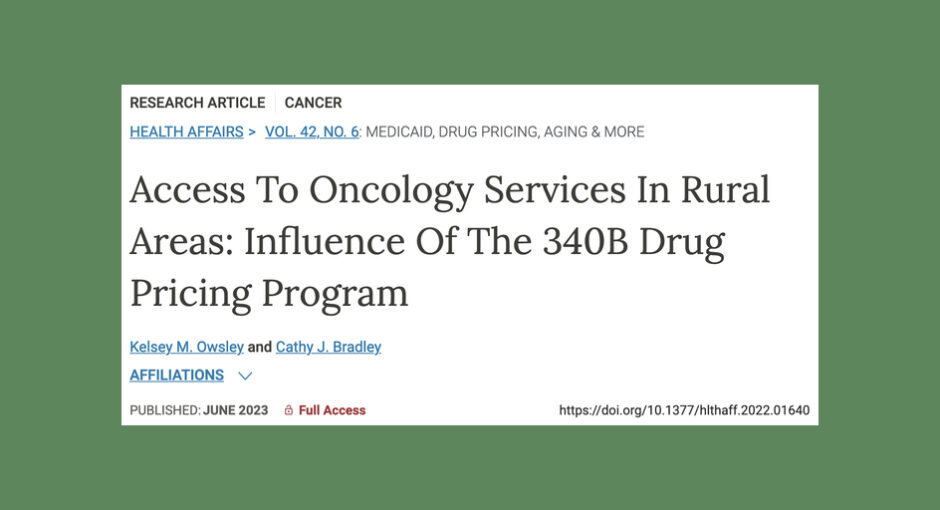Rural hospitals that enroll in the 340B drug pricing program are more likely to initiate oncology services than those that do not participate, a study published online Monday in Health Affairs found.
“It’s estimated that around one in five rural Americans actually live over 60 miles away from a practicing oncologist. And this does have important implications for cancer outcomes such as cancer survival rates,” one of the researchers, Kelsey Owsley from the University of Arkansas for Medical Sciences, said in a related Health Affairs podcast Tuesday.
Another study, published online on Monday in the American Journal of Managed Care, found that 340B hospital and grantee covered entities “are contracting mainly with pharmacies in significantly more affluent neighborhoods than their own.” Prior research suggested that that hospitals and grantees behaved differently in this respect, it said. Drug manufacturer Gilead Sciences funded the study.
Health Affairs study
Owsley, associate member of the UAMS Rockefeller Cancer Institute and assistant professor at the UAMS College of Public Health, and Cathy J. Bradley, associate dean for research in the Colorado School of Public Health and deputy director of the University of Colorado Cancer Center, conducted the study in Health Affairs.
It showed that rural hospitals that enrolled in the 340B program during 2012–2018 were 8.3 percent more likely to have added oncology services as of 2020, compared with hospitals that remained unenrolled through 2020.
“Our findings suggest that the 340B drug pricing program supports rural hospitals’ capacity to deliver oncology services and may improve access to oncology care across rural communities,” the researchers said. The boost from 340B is notable, they said, “given the vast rural-urban disparity in the availability of hospital oncology services and the debate regarding whether hospitals use 340B savings in a manner congruent with the program’s intention: to enable the provision of comprehensive services to low-income populations and reduce disparities in service access.”
A decrease in the enrollee hospitals’ acquisition costs for drugs such as chemotherapies made the costly oncology services more affordable, the analysis suggested.
Still, the newly enrolled 340B hospitals were also most likely to launch oncology services if they were located in Medicaid-expansion states or in areas with a relatively low percentage of uninsured patients. In fact, the researchers noted that, regardless of 340B enrollments, rural hospitals were less likely to add oncology services if they were located in less affluent counties.
Thus, “Policies and programs beyond the 340B program may be necessary to reduce barriers and expand oncology services to the most socioeconomically vulnerable rural areas,” the researchers concluded.
Key findings from the study included:
- 72 (16.9 percent) of 426 rural hospitals added oncology services after 340B enrollment.
- After three years in the 340B program, rural hospitals were 8.4 percent more likely to offer oncology services versus non-participants; after six years, 14.5 percent more likely.
- Medicaid expansion increased the probability of adding oncology services by 7.6 percent.
- New 340B enrollees that added oncology services more likely than those that did not happen to be nonprofit (79 percent versus 52 percent) and in a Medicaid-expansion state (72 percent versus 52 percent).
- New 340B enrollees that added oncology services were more likely to be in counties with lower uninsured rates (mean, 17 percent versus 19 percent), and less likely to be designated a critical access hospital (61 percent versus 85 percent).
AJMC study
Neal Masia, leader of drug industry consultancy Health Capital Group, and Farai Kuwonza, research fellow at Boston University, conducted the study published in AJMC. Masia formerly was Pfizer’s chief economist.
“It is of great interest to policy makers to understand where [contract pharmacies]—for-profit entities, largely—fit into the 340B ecosystem, particularly because they retain an unknown but likely very significant portion of the 340B profits,” the researchers said.
The study found that, on average, median income in the contract pharmacy’s location—or zip code tabulation area (ZCTA)—is about 35% higher than that in the 340B entity’s location.
The analysis, focused on 90,000 pairs of covered entities and contract pharmacies, showed that in 2019, 340B-covered entities contracted with pharmacies in ZCTAs with incomes 25%-30% higher on average than in the covered entity’s ZCTA.
“We find that in 2019, both hospitals and grantees used [contract pharmacies] to generate income, but generally they do not appear to contract with pharmacies located in neighborhoods where low-income patients are likeliest to live,” the researchers said. Given these findings, “Policy makers may seek changes to the program to ensure that 340B profits find their way to patients directly—for example, by limiting the profit participation of the pharmacies themselves,” they said.
There was no major distinction between hospitals and federal grantees, which “suggests that the large, for-profit [contract pharmacies] themselves may be the primary driver of [contract pharmacy] location, raising important questions for policymakers,” the researchers said.
The analysis further showed:
- In 64 percent of the contract pharmacy arrangements overall, the contract pharmacy’s ZCTA median income was higher than that of the covered entity.
- About 72 percent of the contract pharmacy arrangements cover fewer than 100 miles, and within that group, the contract pharmacy’s ZCTA median income was about 27 percent higher.
- In over half of the contract pharmacy arrangements, the contract pharmacy’s ZCTA median income was more than 20 percent higher.
- In over 90 percent of contract pharmacy arrangements, the contract pharmacy and covered entity are in different ZCTAs (89 percent for hospitals, 91 percent for grantees).


